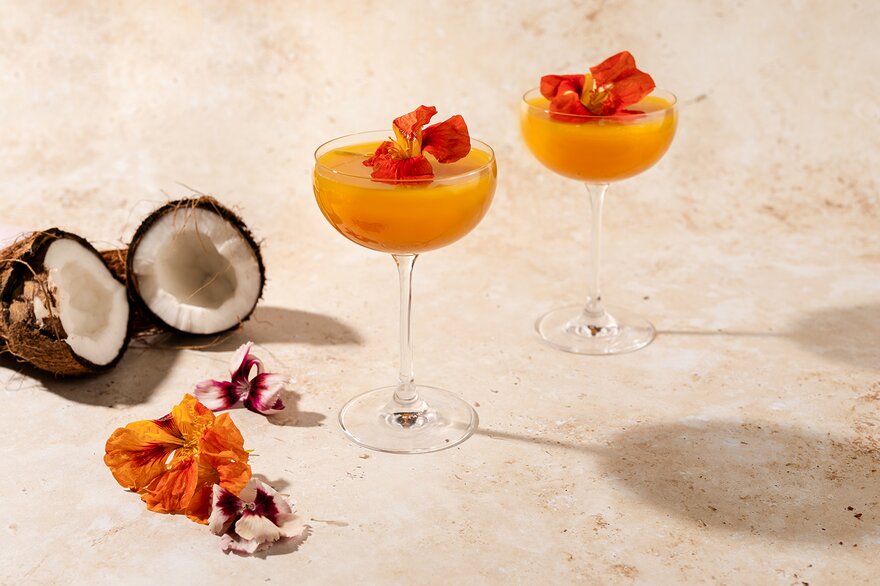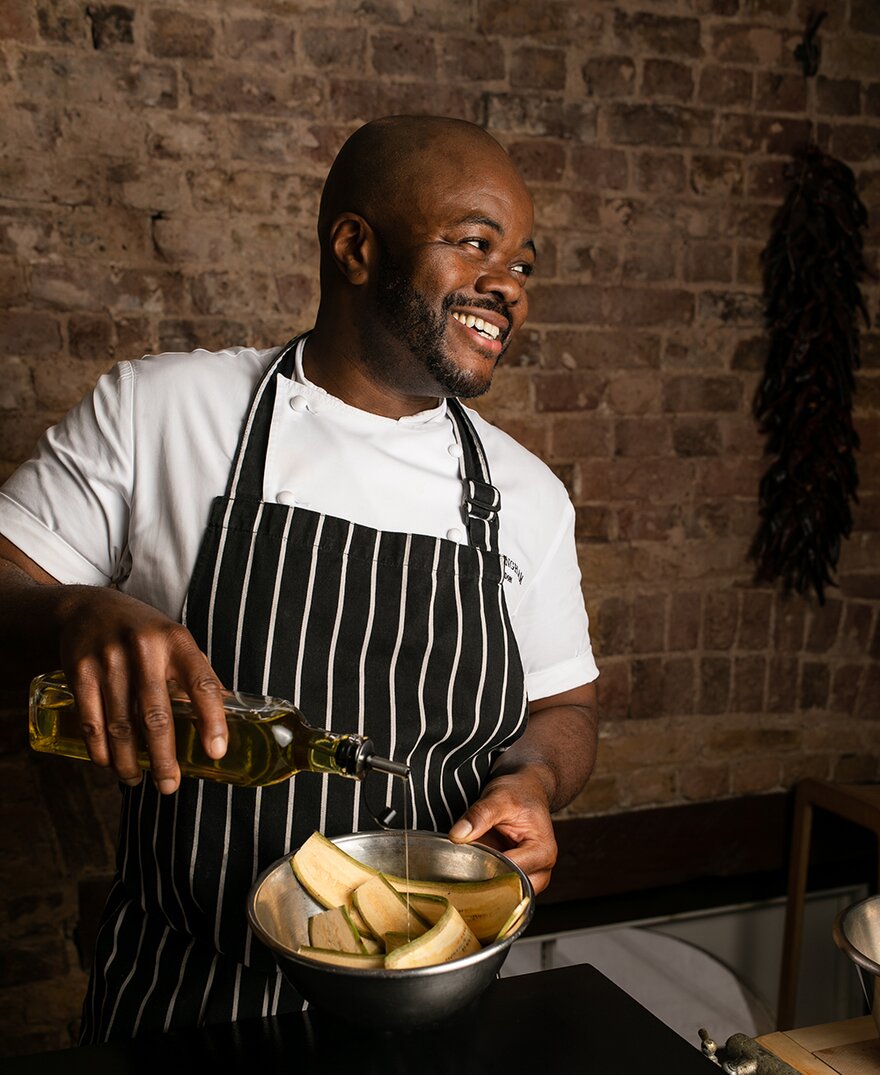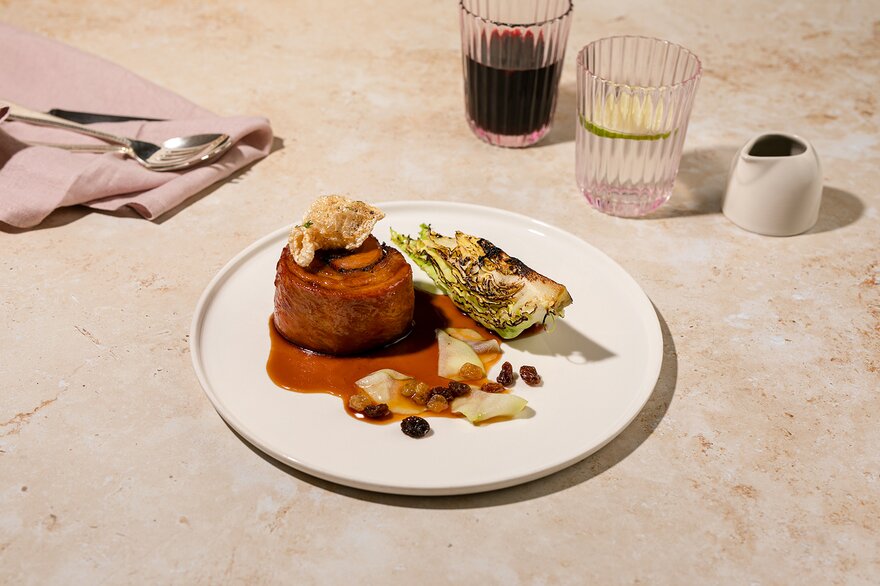The day after Dom Taylor was announced as the winner of a TV chef competition, he opened the Good Front Room at the Langham London. Here's how he managed the seamless transition
Dom Taylor introduced himself to the judges of Channel 4's Five Star Kitchen: Britain's Next Great Chef with a dish of jerk marinated chicken, mac and cheese arancini and twirled plantain chips, arranged on a slate board.
His inaugural pitch was served to judges Michel Roux, Mike Reid and Ravneet Gill, who were to decide if his "reimagined and elevated Caribbean food" could form the basis of a fine dining restaurant at the five-red-AA-star Langham London hotel in the heart of the West End.
Roux initially looked a little puzzled and said: "This whole presentation, it's not five star.
"Making it five star: that's not a step, that's a leap." But as he took his first bite his eyes widened. "It's got a real punch to it. I'd probably even go to the other side of the UK just for this chicken."
As you may have guessed, Taylor won the competition and the chance to open a pop-up restaurant in the Langham London's Palm Court, where his jerk chicken is now being served as a starter. The space, previously a European-style brasserie, has been renamed the Good Front Room, inspired by the chef's great aunt Myrtle, who kept a sacred room for "very special guests".
The 90-cover Caribbean-inspired restaurant is open for a set menu dinner service from Wednesdays to Sundays, where Scottish Loch Duart salmon has been replaced with banana leaf baked sea bream (see recipe), the garden salad with crisp prawn reinvigorated with dark rum-glazed king prawns, dasheen salad and coconut sambal, while side orders of French fries give way to glazed plantain.
"The plantain dressed with coriander, maple and lime – I've been serving it for a long time and people love it because we've been eating plantain the same way for generations," says Taylor, the south London-raised chef born to Jamaican and Saint Lucian parents.
"Michel Roux tasted it and he said ‘I love this dish. Do you know what would be good? Some smoked salt on top'. It blew my mind. It took the dish to a completely different place."
From finale to first opening of the Good Front Room
After filming for the show finished in July 2022, Taylor spent a year refining his dishes, training team members (who were all already employed by the Langham), and recultivating relationships with suppliers such as Windrush Bay to source products including scotch bonnet peppers, breadfruit and dasheen.
The programme finished airing in July, a day before the official opening of the restaurant – the seamlessness of which came as a surprise for some. "I think in the first week, people didn't quite realise we were open. I think they thought I needed time to develop this concept after winning. But as soon as they clocked on, by week two we were fully booked."
The success of the residency has already seen an initial six-month term extended until April 2024, and four months later, Taylor says his food has been attracting a "very diverse" crowd.
"We're getting the Caribbean community, the British Caribbean community, the African community, the British African community, also foodies who have heard of Caribbean food but never tried it, and foodies who love Caribbean food but never had it at this level. It's really exciting for them to see it up there with other great cuisines."
Before his television debut Taylor was working as a private chef with his business, Chef Dom Taylor Kitchen, specialising in Caribbean cuisine. He was also involved in a restaurant residency in Catford, south-east London, where he "really fine-tuned some of the dishes that I subsequently won the show with".
Taylor says that when he was starting out as a chef he was reluctant to pursue Caribbean food professionally. Despite learning to cook his heritage cuisine from his family, especially from his mother and grandmother, he trained in classical French techniques at Lewisham College and then Thames Valley University. He has held positions including head chef of the Belgraves hotel (now the Hari) in London's Belgravia and the Courthouse hotel in London's Shoreditch.
He says: "When I think back to my twenties and early thirties, Caribbean food was still served out of foil containers in little pockets of London and it was a bit hit and miss. There was no pride. No one was really steering the ship. It just didn't feel like there was a career in it for me."
Pioneers of the Caribbean
It wasn't until when he was in his late 30s that Taylor began to see things differently. He noticed Caribbean chefs "really making a stamp" and "doing fantastic things", such as Kerth Gumbs, head chef of Fenchurch at London's Sky Garden, who is from Anguilla, and Barbadian-born Jason Howard, who trained as a sous chef with Hélène Darroze at the Connaught. And yet the lack of recognition shown to Caribbean cuisine from arbiters such as the Michelin Guide indicated the food "wasn't making enough noise".
He says: "These are awards that are given and recognised by other people as benchmarks, so the fact that Caribbean food and black Caribbean chefs haven't got that definitely would have had an impact.
He adds that Caribbean cuisine is too often grouped as one type or misconstrued as solely Jamaican, when in fact the region comprises 13 sovereign countries, ranging from Haiti to Trinidad and Tobago.
"Because Jamaica's got such a strong cultural presence in the UK, when people think about the Caribbean, they think about Jamaica. I'd like to think that people recognise that the Caribbean islands bring a whole different array of flavours, even in the way the dishes are named. For example, in Jamaica we put curry first and then the choice of meat, so it's curry goat or curry chicken, but that isn't the case for all the islands," he says. "If you call it chicken curry in Jamaica, you'll be run out of town!"
Accordingly, his "hands down, number one bestseller" on the menu is chef Dom's curry goat, a hearty dish with a generous portion of braised goat shoulder, crispy breadfruit and roti spiced with thyme, garlic, pimento and scotch bonnet (which is used whole and removed after cooking).
"I add a lot more turmeric than the curry goats I see in Jamaica, but I also say that no curry goat is ever the same. Everybody has their own take," he says.
The addition of the roti as an accompaniment was inspired by the traditions of Saint Lucian and Trinidadian cuisine, which he wanted to spotlight due to his connection via his grandmother.
Similarly a bun and cheese dessert is a tongue-in-cheek, nostalgic play on a traditional hot cross bun-type cake eaten with processed cheese in Jamaica, adapted by Taylor with sweet blue cheese, plantain chutney and sour cherries to offer a delicately balanced mix of sharp and savoury flavours.
As well as the culinary weaving of Caribbean cultures, Taylor has blended his heritage cuisine with his classical French training, which manifest in a side dish of green banana gratin, which has a similar texture to dauphinoise potatoes. He slices bananas in their unripe, green state into ultra-thin sheets using a mandoline, layering them with cream, nutmeg, garlic, thyme, pimento and ginger. Other side dishes include maple, coriander and lime-glazed plantain, tangy okra and fennel slaw, and rice and peas dusted with dried coconut shavings. This too, is a reinterpretation of the cuisine, as he chooses black eye beans over red kidney beans to honour his family tradition. He decided on the side dish format because a "good Caribbean meal that feels like home" is founded on sharing plates.
"What I love about my cuisine is I've literally taken my family teachings and my French classical training and brought them together in this really harmonious way," Taylor says. "I don't think a dauphinoise is eaten in Jamaica, but we understand green bananas, and to the British Caribbean palate, it's ‘I know dauphinoise, I know banana', and suddenly it's like magic."
French technique in a Caribbean context
On the show, Reid, who is culinary director of Rare Restaurants, also drew parallels between Caribbean and French cuisines when he said of Taylor's dish: "It's very homely, but you can take those concepts and then refine it." Taylor confesses that this was not a comparison he was able to draw previously. "Chef Mike has a lot more experience than I have. He was in the game in a different context to me, so he saw the trends of French cooking in a way that I didn't." However, Taylor has been adapting the fundamentals of his cuisine over the course of his career, without necessarily meaning to do so: "Once you make a good white sauce, for example, it's a skill that lasts a lifetime. Even when I'm making a sauce in a Caribbean context, it's rooted in those techniques," he says.
Taylor hopes that by bringing what he has described as naturally rustic and authentic food to the Langham, he's transformed the constraints of fine dining.
"While trying to understand what chef Roux wanted me to do with my cuisine to make it fine dining, I realised it could still have that casual edge that I needed to recognise myself in the dish," he says. "I'm hoping that what I've done is change the idea of what fine dining is. What makes it fine? Does it need perfect lines or can it be a bit more relaxed and just be great cooking on a plate?"
There's no doubt his food sits in a luxury setting and yet it's inviting, approachable – friendly, even. "I wanted it to feel like it shouldn't make sense. I liken it to Chanel clothing. When the designer puts lace and leather together, it shouldn't work, but it does, and it's famous because of it."
He is keen to express immense gratitude for the opportunity to "take what was once upon a time just a dream and make it a reality", but he also confesses that it comes with "a big responsibility to get it right", particularly when so few luxury hotels in London – let alone the UK – showcase Caribbean cuisine.
"It's been really hard to deliver, because there hasn't been an example of this before me. I had to create the road myself and that has been challenging," he explains.
If anything, this has sparked his drive to continue his pursuit of Caribbean fine dining. He has no set plans post-residency as he wants to give the Good Front Room his "undivided attention".
Taylor says: "One of the issues with Caribbean food is consistency and making it my life's work to get that right. I'm going to wait to see what opportunities present themselves before I depart." More television could be on the cards too, and he chuckles as he admits "I really enjoyed watching myself on TV".
He adds: "You have to believe in your gut and believe this can happen to you and believe your time to shine will come. Belief will take you half of the way, and then you have to go and seek out those opportunities."
About the Good Front Room
Opened 15 July
Covers 90
Address The Langham, London, 1C Portland Place, London W1B 1JA
Typical dishes
Starters: Jerk chicken (jerk marinated boneless chicken thigh, plantain jam, plantain crisp, blackened sweetcorn dressing); ackee and salt fish cake (salt cod, confit garlic and scotch bonnet aioli, pineapple heirloom tomato chow, scallion oil).
Mains: Gungo pea daal (herb roasted pumpkin, banana blossom, coconut labneh).
Desserts: Coconut milk soft-serve (dairy-free coconut ice-cream, pineapple compote, plantain chips); cocoa bean (dark chocolate, ginger and coffee layered mousse cake)
Dark rum and raisin pork belly
Serves 4
For the pork belly
- 500g pork belly slices, each approximately
- 1 inch thick
- 2 sprigs thyme
- 1 scotch bonnet, finely chopped
- 1tsp celery salt
- 1tsp ground pimento
- 4 garlic cloves, crushed
- Good quality sea salt and freshly cracked pepper to taste
In a baking tray marinate the pork with all the ingredients for up to 24 hrs. Add 1 litre of water and bake at 150°C for 2-3 hours until the meat is tender. Set aside.
For the dark rum and raisin glaze
- 200ml maple syrup
- Juice and zest of 4 limes
- 50ml soy sauce
- 400ml dark rum
- Good quality salt and pepper to taste
Bring ingredients to the boil and reduce slightly. You want a syrupy consistency. In a large shallow pan add the pork belly to the syrup, spoon it over the meat and reduce the liquid until the pork is covered and sticky.
Lemongrass, pimento and ginger baked sea bream
Serves 4
- 8 sea bream fillets, pin boned
- 4 scotch bonnets, deseeded
- 100g bunch thyme – leaves and soft branches
- 2 bunches spring onions, chopped
- 50g coriander leaves and stalks
- Juice and zest 2 lemons
- 20g whole pimento berries or ground pimento
- 2tsp celery salt
- 2tsp ground cinnamon
- 2tsp ground coriander
- 2tsp ground ginger
- 2 sticks lemongrass, chopped
- 2 inch ginger, peeled and chopped
- 100g garlic cloves, peeled
- 2tsp black peppercorns
- 2tbs salt
- 200ml vegetable oil
Blitz all the marinade ingredients in a blender until smooth. Add half a tablespoon of marinade on the flesh side of each fillet of sea bream, then sandwich together in pairs, so you have four portions.
Bake in a hot oven at 190°C for eight minutes. A cocktail stick should be able to pierce the fish easily when cooked.
Serve with a side salad. If you have leftover marinade, it keeps in the fridge for up to a month in a tightly sealed container.
Continue reading
You need to be a premium member to view this. Subscribe from just 99p per week.
Already subscribed? Log In







